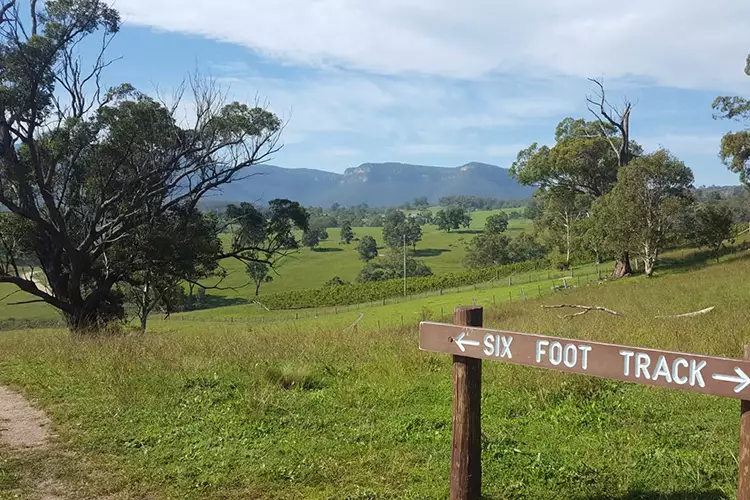The Megalong Valley
For those who know, the Megalong Valley is very special. It’s a place where as children their parents took them for picnics, horse riding and swimming in the clear waters of Megalong Creek. It is one of Australia’s well kept secrets – yet it is so close to Sydney – with its extraordinarily serene rural landscapes, majestic sandstone escarpments, native forests, wonderful bird life and unparalleled sunsets which paint magical pictures on the escarpment walls. There’s no urban encroachment whatever. No subdivision is permitted because the Megalong is at the centre of Sydney’s water catchment and is adjacent to the World Heritage Blue Mountains National Park.
The valley is very old, its bedrock first laid down 450 million years ago.Then about 250 million years ago the area that we now know as the Blue Mountains and the Sydney Basin were inundated by the sea which deposited a deep layer of sand. Over many more millions of years this sand hardened into the sandstone. At the beginning of the Triassic period 200 million years ago when dinosaurs roamed Australia, upward teutonic forces created the sandstone plateau that is the basic mountains landform today. This uplift caused rivers to run more vigorously, eroding the relatively soft sandstone to create the vast network of canyons and gorges – one of which is the Megalong Valley.
Finally, around 17 million years ago, molten igneous rock vented into the valley laying down the granite from which Dryridge vineyard soils are derived and which can be seen today in the form of large spherical boulders.
Following European discovery and the way west through the Blue Mountains, a few hardy families settled in the valley from 1838 grazing cattle and pursuing other agriculture. Timber getting began shortly after. There was significant mining of kerosene shale on the eastern escarpment later still. The first shale mine opened in 1870 and the Megalong township of 200 was quickly established – its ruins can still be seen along the Six Foot Track towards Katoomba, a short and pleasant walk from the estate. The last of the mining was in the first few years of the 20th Century.
Valley Under the Rock
As part of the Gundungurra First Nation territory, the Megalong Valley is profoundly important to Aboriginal people and rich in their heritage. Megalong is thought to have meant ‘Valley Under the Rock’. For over 20,000 years it was an important indigenous pathway linking southern parts with the Hunter Valley; and sections of the Six Foot Track also formed an ancient route to the western tablelands.
The Six Foot Track

The Six Foot Track traverses Dryridge Estate and is one of Australia’s finest scenic walks. It was built in 1887 to provide better access between Katoomba, the principal town in the Blue Mountains, and the Jenolan Caves located in the Great Dividing Range west of the Megalong Valley.
The Jenolan Caves are regarded as the oldest, best decorated and most complex in the world. They were first discovered by European settlers in 1838 and became a major 19th Century tourist attraction despite the difficult journey by horse and buggy across rugged terrain from Tarana, then the closest railway station. Recently-installed internal lighting further highlights the caves visual majesty.
The construction brief for the track provided for a passage six feet wide, so that two laden horses could pass each other -and the brief lives on as its name today. The 45 kilometre track starts at the Explorers’ Tree on the Great Western Highway three kilometres west of Katoomba; travels down Nellie’s Glen to Megalong Road, past the Megalong Cemetery and across Dryridge Estate to the Cox’s River Camping Ground and then onwards to the caves.
Three days are recommended for the complete walk when camping along the route, although many people make day trips to the Cox’s River from the estate turnoff. It is approximately 11 kilometres from the Explorers’ Tree to the estate and five kilometres from the estate to the Cox’s River Camping Ground – just two hours with a light pack.
Our Sunrise Lodge is a luxurious base from which to walk the track. For those that like a challenge, The Six Foot Track is also famous for the Six Foot Track Marathon which is held in March each year and is a 45km marathon following the length of the trail.
We suggest
Drive in two cars to Katoomba. Leave one at the Explorers' Tree, then drive to Dryridge Estate in the second car and spend the evening at our Sunrise Lodge.
Drive to the Jenolan Caves the next morning, leave the car there and then walk back to the Sunrise Lodge - with a light pack this should take between seven to eight hours. Spend the second evening at the Sunrise lodge and complete the final leg of the walk the next morning.
Pick up the first car and drive back to Jenolan for the second
Easy!